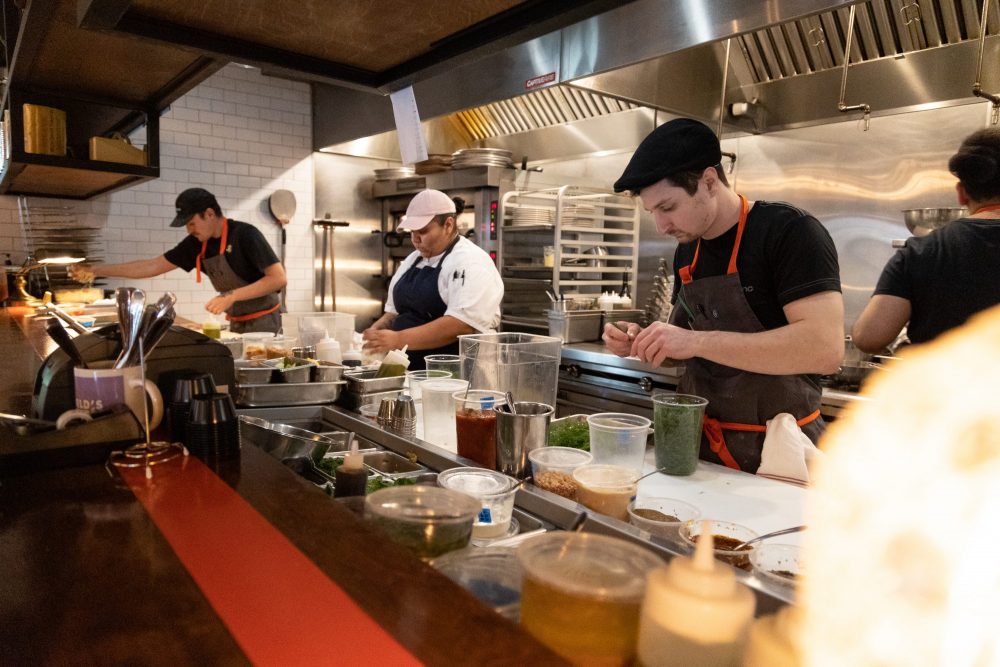Business has picked up since the all time lows of last year for The Grove, a restaurant and event space nestled on the edge of Discovery Green. But now they’re facing a problem many restaurant operators are dealing with: labor shortages.
Finding enough staff to meet the increasing demand for dining over the last few months has been difficult for Jody Fiess, the general manager of The Grove.
“It has been an incredible challenge finding the staff to come back and meet the demand, especially now that the decline in cases are happening and there is an absolute resurgence in demand in going out, being social, having events and carrying on with life as, quote unquote, normal,” Fiess said.
Fiess added that the increase in business and inability to hire the necessary staff to keep up with demand has put a strain on The Grove’s existing workers.
“It’s taxing the people that we do have from the hourly employees to the back of house,” Fiess said. “Everybody is working short-handed.”
This whiplash effect of losing your business all at once and having it return before being fully staffed is something Cameron Latrelle can relate to.
He runs Latrelle’s Management Corporation, a company that operates franchise restaurants inside airports — places like Pink’s Pizza, Hubcap Grill and Wendy’s inside George Bush Intercontinental Airport.
“Obviously COVID was tough on everyone in the industry, but especially for our airport locations,” Latrelle said. “It was a double whammy.”
Business is getting close to what it was before the pandemic, but hiring new staff is still difficult for Latrelle. Airport restaurants don’t have the ease of access that street facing restaurants have for people in search of work.
“At the airport, you have to park in a garage, take a train, this and that, you have to go through a badging process which is basically FBI clearance,” Latrelle said.
Melissa Stewart with the Texas Restaurant Association said workers are looking for better benefits from restaurant jobs, but she adds that those benefits might not be enough to bring back those who left the industry for good.
“Unfortunately, a number of people retired from restaurants when they left us, and we’re just having a hard time getting back,” Stewart said.
About 78% of restaurant operators say they don’t have enough staff to meet current customer demand, according to a poll by the National Restaurant Association.
And that’s not the only thing plaguing restaurant owners — supply chain problems, the delta variant, and inflation have made running a business even more difficult.
So what more can restaurants do to hire and retain staff?
“Our operators who are able to build their workforce or retain their workforce, we do see things like great culture, flexibility, wages, benefits, and being the right place for the right employee,” Stewart said.
Julia Doran is trying to do just that. She is a co-owner of Tiny Champions, a pizza restaurant in East Downtown that opened in December 2020.
“I have been a part of restaurant opening teams before,” Doran said. “Doing it during the tides of the pandemic was more stressful and more difficult than any other restaurant opening I have been privy to.”

Julia Doran, co-owner of Tiny Champions, prepares oysters on Oct. 27, 2021.
Lucio Vasquez / Houston Public Media
While initial hiring went well, the restaurant did have problems hiring back workers this past summer. Doran said Tiny Champions now has a strong group of employees, and credits the competitive wages and benefits the restaurant offers.
“We offer health, dental, and vision, paid time off after a year and a fairly decent family meal every day,” Doran said.
It isn’t just wages and benefits that allows Doran to retain staff. She believes that opportunities for education and growth within the restaurant allow her to keep employees long term.
“We work on really cool stuff,” Doran said. “All of our cooks get to be involved with the making of, you know, the learning and development of new dishes. It’s a fun place to work to expand skills and knowledge.”
Doran has been working in kitchens for 16 years, and said she knows how difficult being a restaurant worker can be. She thinks offering competitive wages is crucial for the industry to continue moving forward.
“Does it mean we might need to nudge prices up a little bit more? Yes,” Doran said. “But our industry has long been behind the curve on this. If it’s a bit more of a competitive market and it’s on the side of the people who are cooking our food, I’m for it.”
For now, restaurant operators are waiting for Congress to replenish the Restaurant Revitalization Fund that ran out in July.
The Texas Restaurant Association estimates only about a third of restaurants that applied received aid and almost $3 billion is still needed to cover pandemic losses for restaurants in Texas.













